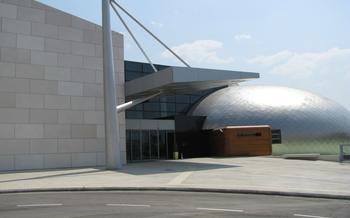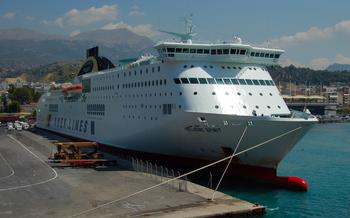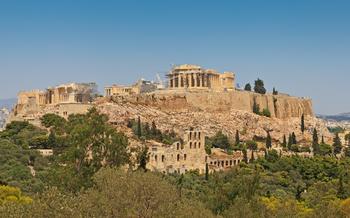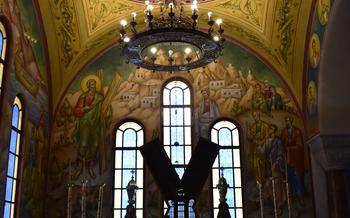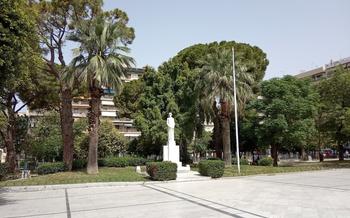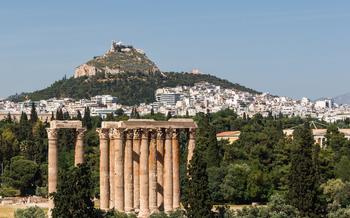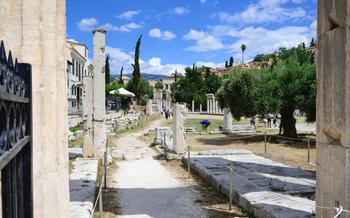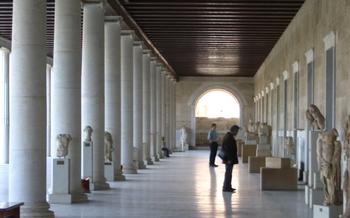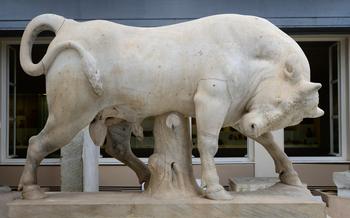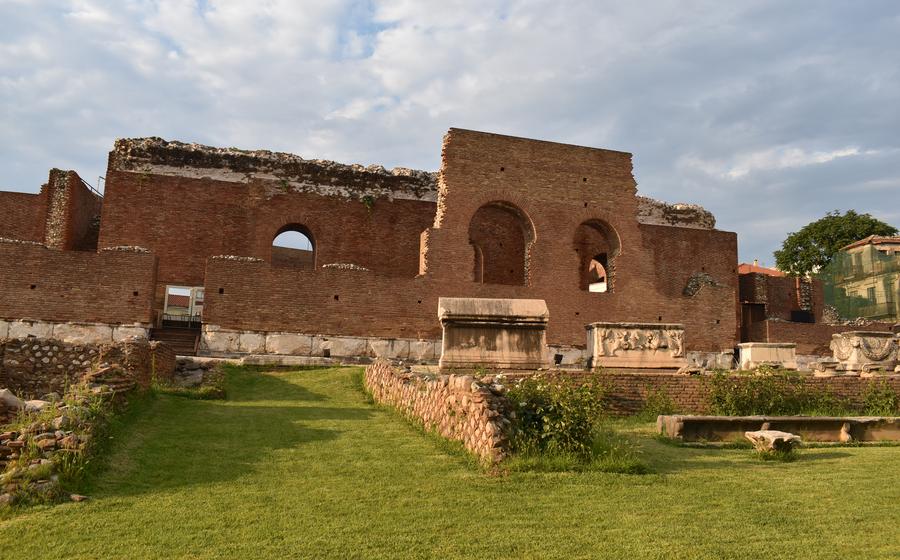
Roman Odeon of Patras
- The Antiquity of Patras
- Roman Odeon: A Hidden Gem
- Location and Historical Significance
- Architectural Features and Design Elements
- Purpose and Function in Ancient Times
- Excavating the Past: The Discovery of the Odeon
- Odeon's Architectural Marvels
- Odeon's Function and Events
- Odeon's Restoration and Preservation
- Visiting the Odeon Today
- Odeon's Role in Modern Patras
- Odeon's Symbolism and Legacy
- Odeon's Link to the Ancient World
- Odeon's Impact on Patras' Development
- Odeon's Educational Value
- Odeon's Unique Experiences
- Odeon's Future Prospects
The Antiquity of Patras
Patras, a vibrant city in western Greece, boasts a rich history dating back to ancient times. In the 6th century BC, it was founded as a colony of the powerful Greek city-state of Achaea. Patras flourished under Greek rule, becoming a significant port and trading center. During the Roman conquest of Greece in the 2nd century BC, Patras fell under Roman rule. The Romans recognized the city's strategic importance and made it the capital of the Roman province of Achaea. Under Roman rule, Patras underwent significant development, with the construction of impressive public buildings, temples, and theaters. Archaeological excavations have unearthed numerous artifacts that shed light on Patras' glorious past, including the well-preserved Roman Odeon, a testament to the city's Roman heritage.
Roman Odeon: A Hidden Gem
Location and Historical Significance
Nestled in the heart of Patras, amidst the vibrant streets and bustling markets, lies a hidden gem that transports visitors back in time - the Roman Odeon. This ancient theater, dating back to the 2nd century AD, is a testament to the city's rich history and its enduring connection to the classical world. Its strategic location within the ancient city, near the agora and other important structures, highlights its significance as a cultural and entertainment hub for the people of Patras.
Architectural Features and Design Elements
The Roman Odeon of Patras stands as an architectural masterpiece, showcasing the ingenuity and artistry of its creators. Constructed using local limestone, the theater features a semi-circular auditorium with tiered seating that could accommodate up to 1,500 spectators. The stage, adorned with intricate carvings and sculptures, provided a captivating backdrop for performances. The Odeon's impressive acoustics, achieved through careful design and the use of ceramic jars, ensured that every word and melody reached the audience with clarity.
Purpose and Function in Ancient Times
The Roman Odeon served as a versatile venue for a variety of events and performances that played a crucial role in the cultural and social life of ancient Patras. It hosted theatrical productions, musical concerts, poetry recitals, and even gladiatorial contests. These spectacles brought together citizens from all walks of life, fostering a sense of community and shared experiences. The Odeon also served as a platform for political assemblies and public announcements, demonstrating its importance as a civic center.
Excavating the Past: The Discovery of the Odeon
In the early 19th century, during the Greek War of Independence, the ruins of the Roman Odeon were first identified by the French traveler and architect Jean-Baptiste Lechevalier. However, it wasn't until 1889 that systematic excavations began under the direction of the German archaeologist Wilhelm Doerpfeld.
The excavation process was challenging due to the depth of the Odeon's remains, which were buried under several meters of earth and debris. Additionally, the site was located in a densely populated area, making it difficult to access and maneuver heavy machinery.
Despite these challenges, Doerpfeld and his team persevered and gradually uncovered the Odeon's well-preserved structure. The excavation revealed the Odeon's orchestra, stage, seating tiers, and many architectural details, providing valuable insights into its original appearance and function.
The discovery of the Roman Odeon was a significant milestone in the archaeological exploration of Patras. It shed light on the city's rich history and cultural heritage, confirming its status as a major center during the Roman period. Furthermore, the Odeon's excavation contributed to a better understanding of Roman theater architecture and its influence on the development of ancient Greek theater.
Odeon's Architectural Marvels
The Roman Odeon of Patras stands out for its exceptional architectural features and design elements. Built in the 2nd century AD, the Odeon showcases the grandeur and artistry of Roman architecture. Its well-preserved structure allows visitors to admire the intricate details and unique characteristics that set it apart from other ancient theaters.
One striking feature of the Odeon is its horseshoe-shaped auditorium, which could accommodate up to 1,500 spectators. The seating rows are divided into three sections, with the lower section reserved for VIPs and officials. The stage area, known as the orchestra, features a raised platform and a backdrop decorated with niches and statues.
The Odeon's acoustics are another remarkable aspect. The carefully designed seating arrangement and the shape of the auditorium create excellent sound quality, ensuring that performances could be heard and understood by all spectators. The stage is slightly elevated, allowing performers to project their voices effectively.
The Odeon's facade is adorned with intricate carvings and moldings, showcasing the skill and artistry of Roman craftsmen. The main entrance features a grand archway flanked by columns and decorative elements. The exterior walls are punctuated by niches and statues, adding to the overall grandeur of the structure.
The Odeon's architectural design showcases the influence of Roman theater-building techniques and aesthetics. Its similarities to other Roman theaters, such as the Odeon of Herodes Atticus in Athens, highlight the widespread use of standardized architectural elements throughout the Roman Empire.
Anecdote: During the excavation of the Odeon, archaeologists discovered a small marble statue of a satyr, believed to have been part of the theater's original decoration. This discovery provided valuable insights into the artistic and cultural significance of the Odeon and its role in ancient Patras.
Odeon's Function and Events
The Roman Odeon of Patras served as a versatile venue for a wide range of events and performances in ancient times. Primarily designed for musical and theatrical presentations, the Odeon's acoustics were carefully crafted to ensure optimal sound quality for both singers and musicians. Renowned performers from across the Roman Empire graced the Odeon's stage, captivating audiences with their talents.
Beyond musical performances, the Odeon also hosted poetry recitals, dramatic plays, and even gladiator fights. These events were immensely popular among the citizens of Patras, who eagerly awaited each spectacle. The Odeon provided a platform for local artists to showcase their skills and gain recognition, fostering a vibrant cultural scene within the city.
One memorable event held in the Odeon was a renowned musical competition. Musicians from various regions gathered to showcase their talents before a panel of esteemed judges. The atmosphere was electric as each performer took the stage, hoping to impress the audience and secure victory. The competition showcased the diversity and richness of musical traditions within the Roman Empire, leaving an unforgettable mark on the city's cultural history.
The Odeon's versatility extended to political and civic events as well. Important announcements, decrees, and proclamations were often made within its walls, ensuring that citizens were well-informed about matters of governance. The Odeon served as a central gathering place where the community could come together to discuss important issues and celebrate significant occasions.
Overall, the Roman Odeon of Patras played a pivotal role in the cultural and social life of the city. By hosting a diverse range of events and performances, the Odeon provided entertainment, education, and a sense of community for the citizens of ancient Patras.
Odeon's Restoration and Preservation
Efforts to restore and preserve the Odeon's structure have been ongoing for decades, with the aim of maintaining its integrity and ensuring its accessibility for future generations. The restoration process has involved careful excavation, cleaning, and repair work, using traditional techniques and materials to maintain the Odeon's authenticity. Challenges in maintaining the Odeon's integrity include the effects of time, weather, and natural wear and tear. The Odeon's exposed location makes it vulnerable to the elements, and regular maintenance is necessary to prevent deterioration. The preservation of the Odeon is of utmost importance, as it serves as a tangible link to Patras' ancient past and a valuable cultural asset for the city.
Anecdote: During the restoration of the Odeon, archaeologists discovered a hidden chamber beneath the stage. Inside the chamber, they found a collection of ancient musical instruments, including lyres, flutes, and drums, which are believed to have been used during performances in the Odeon. This discovery provided valuable insights into the musical traditions of ancient Patras and the importance of music in the cultural life of the city.
Visiting the Odeon Today
The Roman Odeon of Patras stands as a testament to the city's rich history and cultural heritage. Today, visitors can easily access and explore this ancient wonder. Situated in the heart of modern Patras, the Odeon is a short walk from various hotels, restaurants, and shops. Guided tours are available to provide insights into the Odeon's history, architecture, and significance. These tours offer a deeper understanding of the Odeon's role in ancient Patras and its enduring legacy.
As you step inside the Odeon, the impressive acoustics immediately captivate your senses. The theater's design ensures that every word spoken on stage can be heard clearly throughout the auditorium. Imagine the atmosphere during ancient performances, as actors, musicians, and orators captivated audiences with their skills. The Odeon's surroundings offer many opportunities for exploration. Take a leisurely stroll through the picturesque streets, admiring the blend of ancient and modern architecture. Visit the nearby Roman Baths, the Ancient Agora, and the Patras Archaeological Museum to delve deeper into the city's past.
For a truly unique experience, attend a performance or event held in the restored Odeon. Throughout the year, various cultural events, concerts, and theatrical productions grace the stage of this ancient theater. Witnessing a performance in this historic setting is a magical experience that transports you back in time. The Odeon's atmosphere, acoustics, and historical charm create an unforgettable ambiance that will leave a lasting impression.
Odeon's Role in Modern Patras
In contemporary Patras, the Roman Odeon stands as a prominent cultural landmark, attracting visitors from around the world. Meticulously restored and preserved, the Odeon has been transformed into a vibrant venue for a diverse range of events, concerts, and performances. These events showcase the city's rich cultural heritage and provide a unique opportunity for visitors to experience the Odeon's acoustics and grandeur firsthand.
The Odeon's revival as a cultural hub has significantly contributed to Patras' identity as a vibrant and dynamic city. It has become a focal point for artistic expression, attracting renowned performers and artists from Greece and beyond. The Odeon's modern-day events range from classical concerts and theatrical productions to contemporary performances and festivals, catering to a wide range of audiences.
One notable event held annually at the Odeon is the Patras International Festival. This prestigious festival brings together renowned musicians, dancers, and performers from around the world, showcasing their talents in captivating performances that enthrall audiences. The festival transforms the Odeon into a hub of creativity and cultural exchange, attracting visitors from across the globe.
The Odeon's restoration and transformation into a vibrant cultural venue have breathed new life into Patras' cultural scene. It has become a symbol of the city's commitment to preserving its heritage while embracing contemporary artistic expression. The Odeon's modern-day events not only entertain and inspire but also contribute to the city's tourism industry, attracting visitors eager to experience the unique atmosphere of this ancient venue.
Odeon's Symbolism and Legacy
The Roman Odeon of Patras stands as a testament to the enduring legacy of ancient Greek culture. Its symbolic significance extends far beyond its physical structure, weaving itself into the very fabric of Patras' identity.
-
Symbol of Heritage: The Odeon is a constant reminder of Patras' rich past, a tangible link to the ancient world that once thrived on these shores. It represents the city's deep-rooted traditions, its connection to a glorious heritage that continues to inspire and shape its modern-day character.
-
Representation in Art: The Odeon's iconic image has found its way into various forms of local art and literature. Artists, poets, and storytellers have drawn inspiration from its timeless beauty, incorporating it into their works as a symbol of Patras' grandeur and cultural heritage.
-
Local Folklore: The Odeon is deeply embedded in the folklore of Patras, featuring in tales and legends that have been passed down through generations. These stories often speak of the Odeon's mystical aura, its connection to ancient spirits, and its role in shaping the city's destiny.
-
Legacy of Greek Culture: As an enduring symbol of ancient Greek culture, the Odeon represents the enduring power of artistic expression and creativity. It stands as a reminder of the significant contributions that Greece has made to the world of theater, architecture, and the arts, leaving an indelible mark on global culture.
Odeon's Link to the Ancient World
The Roman Odeon of Patras stands as a tangible connection to the ancient Greek world, providing a glimpse into the cultural and artistic achievements of a bygone era. Its architectural design, acoustics, and stage layout mirror those of other ancient theaters and Odeons, offering valuable insights into the performance practices and theatrical traditions of ancient Greece.
The Odeon's existence in Patras, a city with a rich history dating back to antiquity, further cements its link to the ancient world. Patras, once a prominent city-state in Achaea, played a significant role in the political, economic, and cultural landscape of ancient Greece. The presence of the Odeon within its walls speaks to the city's cultural sophistication and its embrace of the arts.
Moreover, the Odeon's discovery and subsequent excavation have unearthed a wealth of artifacts and inscriptions that shed light on the daily lives, beliefs, and customs of the ancient Greeks. These findings provide valuable context for understanding the significance of the Odeon and its role within the broader framework of ancient Greek society.
The Odeon of Patras serves as a living testament to the enduring legacy of ancient Greek culture. Its architectural grandeur, coupled with the historical context of Patras, offers visitors a unique opportunity to experience the tangible remains of a civilization that laid the foundation for Western thought, art, and theater.
Odeon's Impact on Patras' Development
The Roman Odeon of Patras has played a significant role in shaping the city's urban landscape, cultural identity, and economic growth. Its presence has left an indelible mark on the development of Patras, transforming it into a vibrant cultural hub.
-
Urban Landscape: The Odeon's strategic location within the ancient city center has influenced the urban planning and development of Patras. Its proximity to other significant landmarks, such as the Roman Baths and the Ancient Agora, has created a rich cultural district that attracts visitors from around the world.
-
Cultural Identity: The Odeon has become an integral part of Patras' cultural identity. It serves as a tangible reminder of the city's rich history and connection to the ancient Greek world. The Odeon's unique architecture and design have inspired local artists, writers, and musicians, who often incorporate elements of the Odeon into their creative works.
-
Tourism and Economic Growth: The Odeon has become a major tourist attraction in Patras, drawing visitors who are eager to explore its ancient ruins and experience its unique atmosphere. The Odeon's restoration and preservation efforts have contributed to the city's growing tourism industry, generating revenue and creating employment opportunities for local businesses.
Anecdote:
In recent years, the Odeon has become a popular venue for hosting cultural events, concerts, and performances. One memorable event was a theatrical production that brought the ancient Greek tragedy of "Medea" to life within the Odeon's historic walls. The performance was a resounding success, captivating audiences with its authenticity and transporting them back in time.
Odeon's Educational Value
The Roman Odeon of Patras stands as a valuable resource for education and research, offering a wealth of knowledge about ancient Greek theater, architecture, and history. Archaeological studies and historical investigations conducted at the Odeon have shed light on the construction techniques, design principles, and cultural significance of this ancient monument. Through meticulous excavations and analysis, archaeologists have uncovered artifacts, inscriptions, and architectural elements that provide insights into the daily life, entertainment, and artistic traditions of Patras during the Roman period.
Scholars and researchers from around the world have descended upon the Odeon to study its unique features and gain a deeper understanding of ancient Greek society. The Odeon's well-preserved structure and acoustics have made it an ideal venue for archaeological experiments and reenactments, allowing experts to reconstruct performances and explore the theatrical experiences of the past. Furthermore, the Odeon's proximity to other significant archaeological sites, such as the Roman Baths and the Ancient Agora, has facilitated a comprehensive understanding of Patras' urban development and cultural heritage.
The Odeon's educational value extends beyond academic circles, captivating the imaginations of students, history enthusiasts, and tourists alike. Guided tours and educational programs offered at the site provide visitors with a glimpse into the daily lives of ancient Greeks, the evolution of theater and entertainment, and the architectural marvels of the Roman Empire. Interactive exhibits, multimedia presentations, and hands-on activities bring the past to life, fostering a deeper appreciation for the Odeon's historical significance and its enduring legacy.
Odeon's Unique Experiences
Visiting the Roman Odeon of Patras offers a multitude of unique and unforgettable experiences that transport visitors back in time to the era of ancient Greece. Attending a performance or event in the restored Odeon is an unparalleled opportunity to immerse oneself in the ambiance and acoustics of this ancient theater. The Odeon's intimate setting and exceptional acoustics create an enchanting atmosphere that brings the performances to life.
Exploring the Odeon's surroundings and neighboring attractions provides further insights into the city's rich history. Visitors can wander through the ruins of the Roman Baths, once a place of relaxation and rejuvenation for Patras' citizens. The Ancient Agora, located nearby, offers a glimpse into the bustling marketplace and social center of the ancient city.
Discovering hidden corners and untold stories related to the Odeon adds a layer of intrigue to the experience. Exploring the Odeon's underground chambers, uncovering hidden inscriptions, or learning about the legends and myths associated with the theater provides a deeper connection to its past. Each visitor can create their own unique narrative as they delve into the mysteries of the Odeon.
Odeon's Future Prospects
The Roman Odeon of Patras continues to captivate visitors with its enduring charm and historical significance. As we look to the future, there are exciting prospects and plans in store for this ancient treasure. Ongoing efforts are dedicated to preserving and restoring the Odeon's structure, ensuring its longevity for generations to come.
One of the most anticipated developments is the hosting of future events, exhibitions, and educational programs within the Odeon's walls. Imagine attending a mesmerizing concert or theatrical performance under the stars, surrounded by the Odeon's ancient acoustics. These initiatives aim to breathe new life into the Odeon, transforming it into a vibrant cultural hub once again.
Furthermore, the Odeon's potential as a major cultural destination in Greece is immense. With its unique history and architectural features, the Odeon has the potential to attract visitors from around the world. Its strategic location within the city of Patras, coupled with its proximity to other historical sites, makes it an ideal destination for cultural enthusiasts and history buffs alike.
As the Odeon embarks on this exciting journey, there is a sense of anticipation and enthusiasm among the local community and visitors alike. The future holds endless possibilities for the Roman Odeon of Patras, and it is poised to play an even greater role in shaping the city's cultural identity and tourism.
